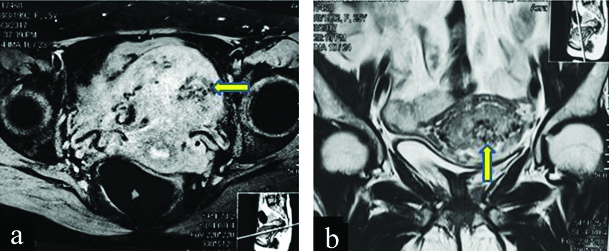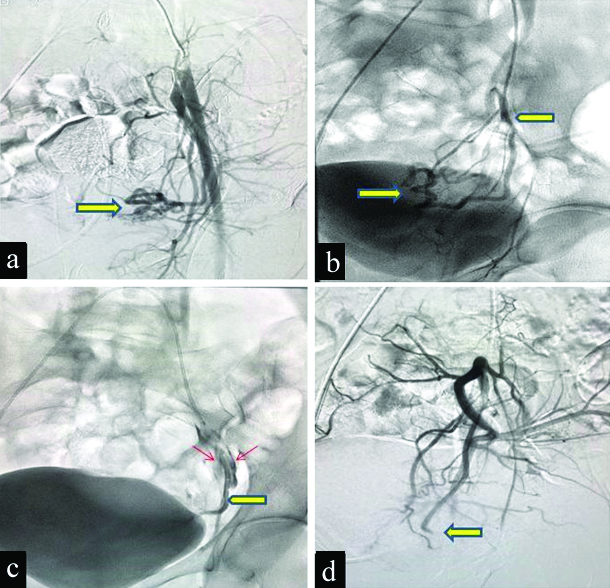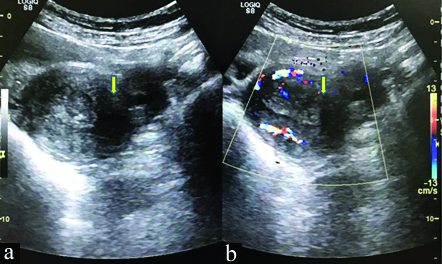Transarterial Embolisation of Post-traumatic Uterine AVM-Uterus Salvaging Minimally Invasive Treatment Option
Udit Chauhan1, Jaya Chaturvedi2, Mohit Tayal3
1 Assistant Professor, Department of Diagnostic and Intervention Radiology, All India Institute of Medical Sciences, Rishikesh, Uttarakhand, India.
2 Professor and Head, Department of Obstetrics and Gynaecology, All India Institute of Medical Sciences, Rishikesh, Uttarakhand, India.
3 Senior Resident, Department of Diagnostic and Intervention Radiology, All India Institute of Medical Sciences, Rishikesh, Uttarakhand, India.
NAME, ADDRESS, E-MAIL ID OF THE CORRESPONDING AUTHOR: Dr. Udit Chauhan, Assistant Professor, Department of Intervention and Diagnostic Radiology, All India Institute of Medical Sciences, Rishikesh-249203, Uttarakhand, India.
E-mail: dr.udit.chauhan@gmail.com
Uterine Arterio-Venous Malformations (AVM) is uncommon causes of uncontrolled uterine bleeding. The incidence of their occurrence is rare and is mostly associated with trauma following Dilatation and Curettage (D&C). Their recognition is important as they could lead to life threatening haemorrhage and death. Diagnosis includes a high index of suspicion coupled with modalities like colour Doppler and MRI. Hysterectomy was the main stay of treatment in the past, but in current scenario, angioembolisation is considered as the best treatment option, since most of the patients are in the young reproductive age group. Authors present a case of post D&C uterine AVM in a young female who presented with persistent uterine bleeding and was successfully treated with angioembolisation using Poly Vinyl Alcohol (PVA) particles and gel foam. We also wish to highlight important diagnostic features of uterine AVM along with available treatment options.
Angiography,Gel foam,Poly vinyl alcohol particles
Case Report
A 25-year-old female came to the obstetrics and gynaecology outpatient department with chief complaint of bleeding per vaginum for past three months along with persistent lower abdominal pain. This was subsequent to medical abortion and D&C of her 12 weeks intrauterine gestation. She had undergone D&C twice to address the bleeding which only worsened with time. In past medical history she was G2, P1, A1 and L1 with previous uneventful normal vaginal delivery. She never had any history of excessive vaginal bleeding and had regular 30 days menstrual cycle with bleeding lasting for five days.
Clinical examination of the patient revealed severe anaemia. Mildly bulky uterus was found on per vaginum examination with normal appearing cervix and adnexae. Laboratory tests were unremarkable except for low haemoglobin of 7.5 g/dL. Patient was referred to radiology department for further evaluation. Ultrasound pelvis with Doppler evaluation revealed mildly bulky uterus with an abnormal tuft of anechoic channels of approximate 2 cm×2.5 cm size displaying both arterial and venous flow located in the myometrium of fundal region on left side. Diagnosis of AVM was suggested and MRI was performed to look for any other pelvic abnormality. The MRI of pelvis revealed similar findings with anechoic channels seen as flow voids deriving the vascular supply from left adnexa [Table/Fig-1]. Based on the radiological findings and clinical history, a diagnosis of post traumatic AVM of uterus was suggested. Case was discussed with the gynaecologist and keeping in view the young age and future fertility issue of the patient, a decision to carry out Trans Arterial Angioembolisation (TAE) of AVM was taken.
Axial fat saturated T2 (a) and coronal T2 weighted images (b) displaying tuft of serpiginous flow voids in the uterine fundus on left side (arrows in ‘a’ and ‘b’). Major supply is seen entering from the left side. No other tuft of vessels is visualised in the pelvis.

After informed consent was taken and mild sedation with fentanyl, ante grade puncture of right common femoral artery was done followed by placement of 6F vascular access sheath. Thereafter, left uterine artery was engaged with 5F C2 catheter and angiography was done which revealed a large tuft of serpiginous arteries arising from left uterine artery and draining into the dilated venous system [Table/Fig-2a,b]. Thereafter, the uterine artery was selectively injected with slow injection of PVA particles of 300-500 micron till sluggish flow was seen which was followed by injection of gel foam slurry till complete cessation of flow was seen [Table/Fig-2c]. There was inadvertent dissection of short segment of uterine artery near origin during procedure, which resolved during later part of procedure [Table/Fig-2c]. Check angiogram revealed patency of left uterine artery with non-visualisation of AVM [Table/Fig-2d].
Angiographic images of left common iliac artery (a) displaying tuft of serpiginous arteries arising from left uterine artery (arrow in ‘a’), selective cannulation of left uterine artery (arrow head in ‘b’) showing the AVM (arrow in ‘b’). Angiographic image of left uterine artery displaying complete stasis of contrast in the artery with non visualisation of AVM post embolisation (arrow head in ‘c’), note short segment of dissection in the proximal uterine artery shown by red arrows in ‘c’. Post procedure DSA (digital subtraction angiography) in right anterior oblique view displaying completely patent left uterine artery with non opacification of AVM (arrow in ‘d’).

Angiogram from right uterine artery was taken and it revealed no tortuous vascular channels communicating with AVM. Puncture site was compressed after removal of sheath. Patient was allowed semi solid food followed by normal diet. Ultrasound Doppler was done on next day which revealed echogenic appearance of the previously seen anechoic channels without any colour flow. At this point, patient reported complete cessation of bleeding and was called for follow up after three weeks.
At three weeks follow up, there was complete resolution of AVM channels and no area of increased vascularity was seen in the fundal region [Table/Fig-3a,b]. Rest of the pelvic organs were unremarkable.
Axial view of lower abdomen in grey scale (a) and colour Doppler (b) displaying ill defined heterogeneous area in fundal region on left side (arrow in ‘a’) without any significant colour flow on Doppler images (arrow in ‘b’) suggestive of thrombosed AVM.

Discussion
Uterine AVM’s are uncommon disorders but can cause life-threatening bleeding. Nearly 100 cases are reported in the literature since 1926. Most of them occur in age group from 18-72 years and are rarely seen in nulliparous females. They are characterised by multiple communicating channels between arteries and veins lying in close vicinity to each other. They can be characterised as congenital and acquired [1,2]. Amongst various imaging modalities, ultrasonography coupled with coloured Doppler and MRI remain the mainstay diagnostic modalities as both can diagnose the condition as well as help to define the pelvic extent of the disease [3,4].
Congenital AVM are the aberrations of abnormal embryonic development of primitive vascular structures ending into the abnormal arteriovenous channels. Acquired AVM are usually post traumatic and result from post D&C, after uterine surgery and uncommonly from conditions like carcinoma endometrium, carcinoma cervix and molar pregnancy [5].
The most common clinical presentation is severe uterine bleeding which starts and stops abruptly to recur again after unpredictable time for unpredictable duration. Other clinical features include lower abdominal pain, painful coitus and anemia. Very severe shunting if present can manifest as dyspnoea on exertion along with cardiac decompensation [4].
In the past uterine AVM were diagnosed by laprotomy or pathologically after hysterectomy. Grey scale ultrasound features of uterine AVM include presence of anechoic tuft of channels with serpentine contour seen in the myometrial region of the uterus. These findings are confusing and non specific. Colour Doppler is more definitive as it shows colour flow in these anechoic channels. Huang MW et al., suggested two colour patterns associated with uterine AVMs. The first is the juxtaposition of red and blue components suggestive of blood flow reversals due to overlapping vessels of different orientations and flow directions. The second is colour aliasing and the separation of blue and red components by yellow and white, suggesting focal high velocities. Spectral Doppler shows low-resistance and high-peak systolic velocities with continuous high flow throughout systole and diastole [5].
The MRI provides accurate evaluation of uterine AVMs and precisely delineates invasion into adjacent organs. Diagnostic features include a bulky uterus with a focal mass along with disruption of the junctional zones. It also demonstrates multiple serpiginous flow-related signal voids within the lesion along with prominent parametrial vessels. Contrast enhanced MRI shows hyper vascular arterial dominant flow [6]. The present case had similar findings to that described in the aforementioned literature.
Various treatment options which are available for post traumatic AVMs includes medical management, hysterectomy and single or bilateral uterine artery ligation. In current scenario, TAE is the best available treatment for post-traumatic AVM in young fertile patients as it is efficacious and expeditious method to achieve thrombosis of AVM along with retaining menstruation and fertility in the young age group.
Various authors have described use of different embolising agents in the treatment of uterine AVM. In a review by Ghai S et al., they have described 25 embolisation procedures in 15 patients over a time span of 10 years. They have described use of PVA particles; gel foam, metallic coils and glue, based on expertise and preference of operator and have reported a technical success of 100% with clinical success of 93% [4].
Yazawa H et al., have reported a similar case of uterine AVM which was treated with danazol followed by glue embolisation of unilateral uterine artery and ovarian artery [7].
We have used combination of PVA particles and gel foam slurry based on our experience at other sites in the body and ability to control the injection. We recommend use of this combination as it is both cost effective and is easy to use.
Conclusion
The authors conclude that TAE of traumatic uterine AVM’s is an efficacious and expeditious treatment option which retains the reproductive functions of the most commonly affected age group of this condition and obviates the need of hysterectomy. Further we suggest that use of PVA particles with gel foam slurry serve as good embolising agents for treatment of this entity.
[1]. Diwan RV, Brennan JN, Selim MA, McGrew TL, Rashad FA, Rustia MU, Sonographic diagnosisof arteriovenous malformation of the uterus and pelvis J Clin Ultrasound 1983 11(5):295-98.10.1002/jcu.18701105126409944 [Google Scholar] [CrossRef] [PubMed]
[2]. Abu Musa A, Hata T, Hata K, Kitao M, Pelvicarteriovenous malformation diagnosed by colour flow Doppler imaging AJR Am J Roentgenol 1989 152(6):1311-12.10.2214/ajr.152.6.13112655394 [Google Scholar] [CrossRef] [PubMed]
[3]. Palmaz JC, Newton TH, Reuter SR, Bookstein JJ, Particulate intraarterial embolization in pelvicarteriovenous malformations AJR Am J Roentgenol 1981 137:117-22.10.2214/ajr.137.1.1176787861 [Google Scholar] [CrossRef] [PubMed]
[4]. Ghai S, Rajan DK, Asch MR, Muradali D, Simons ME, TerBrugge KG, Efficacy of embolisation in traumatic uterine vascular malformations J Vasc Interv Radiol 2003 14(11):1401-08.10.1097/01.RVI.0000096761.74047.7D14605105 [Google Scholar] [CrossRef] [PubMed]
[5]. Huang MW, Muradali D, Thurston WA, Burns PN, Wilson SR, Uterine arteriovenous malformations:gray-scale and Doppler US features with MR imaging correlation Radiology 1998 206(1):115-23.10.1148/radiology.206.1.94236609423660 [Google Scholar] [CrossRef] [PubMed]
[6]. Grivell RM, Reid KM, Mellor A, Uterine arteriovenous malformations: a review of the current literature Obstet Gynecol Surv 2005 60(1):761-67.10.1097/01.ogx.0000183684.67656.ba16250925 [Google Scholar] [CrossRef] [PubMed]
[7]. Yazawa H, Soeda S, Hiraiwa T, Takaiwa M, Fujimori K, A case of severe uterine arteriovenous malformation treated with danazol followed by a transarterial embolization of unilateral uterine and ovarian arteries Gynecology and Minimally Invasive Therapy 2015 4(4):149-53.10.1016/j.gmit.2015.10.001 [Google Scholar] [CrossRef]